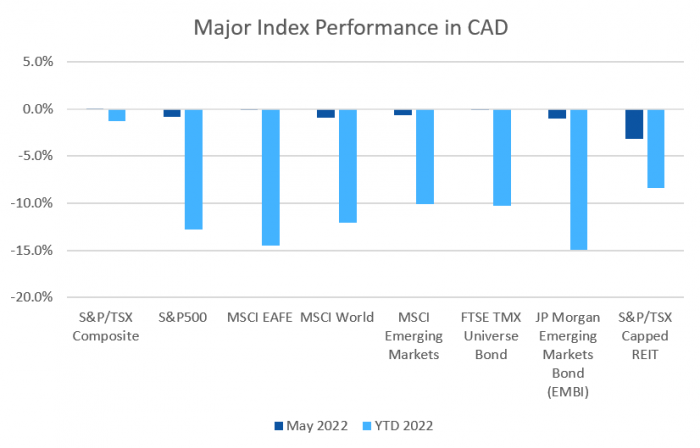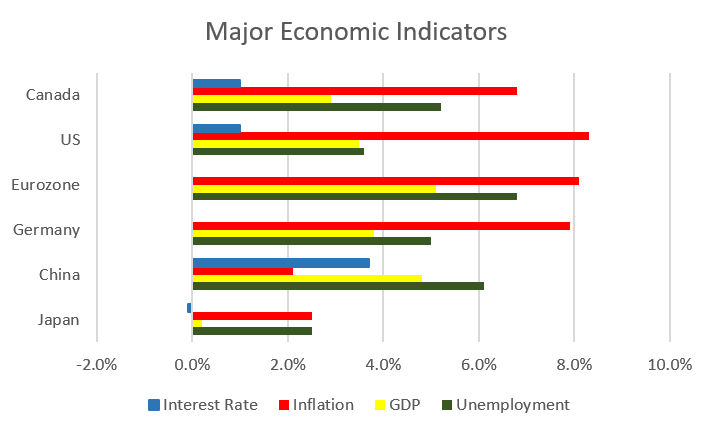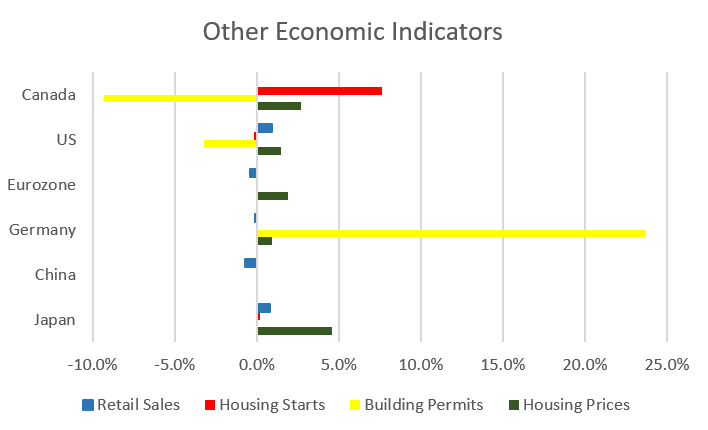May was mixed for equity markets, though none showed much strength. Fixed income was also mixed, and certainly didn’t provide much of a safe haven from equity market volatility.
May 2022 Market Performance
All index returns are total return (includes reinvestment of dividends) and are in Canadian Dollars unless noted.
| Other Market Data | Month-end Value | Return for May 2022 | 2022 YTD Return |
|---|---|---|---|
| Oil Price (USD) | $114.67 | +9.53% | +52.47% |
| Gold Price (USD) | $1,848.40 | -3.31% | +1.08% |
| US 3 month T-bill | +1.16% | +0.31%* | +1.40%* |
| US 10 year Bond | +2.85% | -0.04%* | +1.10%* |
| USD/CAD FX rate | 1.2648 | -1.13% | -0.24% |
| EUR/CAD FX rate | 1.3561 | +0.51% | -5.77% |
| CBOE Volatility Index (VIX) | 26.19 | -21.82% | +52.09% |
*Absolute change in yield, not the return from holding the security.
May was mixed for equity markets, though none showed much strength. Fixed income was also mixed, and certainly didn’t provide much of a safe haven from equity market volatility.
The S&P/TSX Composite finished May flat (+0.06%), leaving the YTD return at -1.3%. The S&P/TSX Small Cap was down -2.4%, turning it negative for 2022. US markets performed about the same; the large cap S&P500 gained +0.2% (in USD), and its now down -12.8% for 2022. The index of US small cap stocks, the Russell 2000, was flat for the month (-17.0% for 2022), and the tech focused Nasdaq lost another -2.1% (-22.8% for 2022).
The broad index of EAFE (Europe, Australasia & Far East) stocks was one of the better performers in May, losing -0.7% (-6.8% for 2022). Out of the EAFE regions, European stocks performed similarly, losing -1.0% for the month, meanwhile British stocks were up +0.8% (+3.0% for 2022!). Japanese stocks were one of the top performers in May, gaining +1.6%. Emerging market stocks were down -0.5% for May and -10.4% for 2022.
Bond markets continue to struggle with the prospect of higher interest rates; most indexes we track posted their fifth negative month in a row, with many having their worst start to the year in decades.
The major Canadian bond index, the FTSE/TMX Universe Bond Index lost -0.1% in May, bringing the YTD loss to -10.3% – its worst drawdown since 1994! The FTSE/TMX Short-term Bond Index gained +0.2% for the month, and is down -3.6% for 2022. In the US, investment grade bonds snapped their 5 month losing streak. The ICE BoA AAA index gained +0.9% for May, bringing the YTD loss to -13.6%. The BBB index gained +0.4% for May. High yield bonds gained +0.3% in May for the HY Master II Index, while the CCC and lower (the real junky stuff) Index lost -0.3%. Emerging market bonds were down -1.0% for May and -14.9% for 2022.
REITs were down -3.2% in May, and are down -8.4% for 2022.
Oil neared the US $120 per barrel level, gaining +9.5% in May, and it is now up +52.5% for 2022. Gold lost -1.9% in May. The diversified Bloomberg Commodities Index gained +1.4% in May, and its up +32.4% for 2022.
In May the Canadian Dollar (CAD) gained -1.1% against the US Dollar, and lost -0.5% against the Euro.
May 2022 Economic Indicator Recap
Below are the readings received in May for the major economic indicators: central bank interest rates, inflation, GDP and unemployment.
Below are the current readings on a few other often followed economic indicators: retail sales and housing market metrics.
A Closer Look at the Canadian Economy
Canada’s unemployment rate dropped to 5.2% in April, the lowest rate on record since comparable data became available in 1976. Employment levels were stable, with the Atlantic provinces seeing most of the gains. The unemployed population declined -14,400 (-1.3% to 1,085,000). The economy added 15,500 jobs, 47,100 were part time jobs, while 31,600 full time jobs were lost.
Housing prices across Canada were up +2.7% in April, with 10 of 11 major markets posting gains. The top gainers were Halifax (+3.9%), Hamilton (+2.8%), and Ottawa (+2.7%). The annual national price gain for the 12 months ended April 30 was +18.8%, a new record. Halifax was almost double that at +34.8%.
The level of new housing starts rose +7.6% to 267,330 units in April. Urban housing starts jumped +10% as multifamily (condo and townhouse) construction rose +14%. The value of building permits issued declined -9.3% in March to $11.7 billion, led by a -29.5%. Residential construction rose +4.7%.
The inflation rate for April was +0.6%, and +6.8% on an annual basis – the highest annual inflation rate since January 1991! Prices rose in all eight parts of the index: Transportation was +11.2%, gasoline +36.3%, shelter +7.4%, food+8.8%. Core inflation which excludes more variable items such as gasoline, natural gas, fruit & vegetables and mortgage interest was +5.7%.
Retail sales were flat in March, with 10 of 11 sectors posting increases; a -6.4% decline at new car dealers offset the gains in the other 10 sectors. Compared to a year ago, retail sales were up +2.7%.
Canada’s GDP grew +0.7% in March, with 14 of 20 sectors posting gains. The goods producing sectors grew +0.9%. The services sectors grew +0.6%, with accommodation and food services the biggest gainer at +10.9%.
As expected, after months of inflation higher than we’ve seen in more than a decade, the Bank of Canada raised interest rates +0.50% to +1.50% at the June 1st meeting. The benchmark interest rate is expected to be raised a few more times this year as the BoC expects inflation to remain elevated.
The Bank of Canada also continued the process of quantitative tightening (the reverse of quantitative easing seen at the start of the pandemic and in the financial crisis). Maturing bonds will no longer be replaced with new purchases, which will shrink the size of the Bank’s balance sheet. This will in effect remove a large bond buyer from the market and increase the yields seen on longer term bonds (and fixed rate mortgages).
*Sources: MSCI, FTSE, Morningstar Direct, Trading Economics



